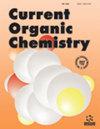Design, Synthesis, and Antimicrobial Evaluation of Novel Sulfonamide Modified with Azoles
IF 2.1
3区 化学
Q3 CHEMISTRY, ORGANIC
引用次数: 0
Abstract
Background:: Sulfonamide, imidazole, and triazole chemical nuclei possess good antimicrobial potential. Aims:: This study aimed to amalgamate sulfonamide, imidazole, and triazole moieties in a single molecular framework with the intent of improving their antimicrobial activities. Objective:: The objective of this study was the synthesis of conjugates containing sulfonamide and azole moieties along with in vitro and in silico evaluation as antimicrobial candidates. Method:: A series of sulfonamide-modified azoles (7a-r) was synthesized by multicomponent condensation of 1,2-dicarbonyl compounds, ammonium acetate and aryl-substituted aldehydes in glacial acetic acid. The structure of synthesized molecules was elucidated with the help of various spectroscopic techniques, such as FTIR, NMR, and HRMS. The target molecules were tested for in vitro antimicrobial potency against four bacterial strains and two fungal strains. Result:: Molecules 7c (MIC 0.0188 μmol/mL), 7f (MIC 0.0170 μmol/mL) and 7i (MIC 0.0181 μmol/mL) were most active against S. aureus and C. albicans. Against E. coli, molecules 7d (MIC 0.0179 μmol/mL), 7f (MIC 0.0170 μmol/mL) and 7i (MIC 0.0181 μmol/mL) were found to be highly active. Moreover, the binding conformations were investigated by in-silico molecular docking, and QTAIM (Quantitative theory of atoms in the molecule) analysis was also performed. Molecular properties, such as the heat of formation, HOMO energy, LUMO energy and COSMO volume, were found to be in direct correlation with the antimicrobial potency of molecules 7c, 7f and 7i against S. aureus and C. albicans. Conclusion:: All the synthesized molecules were more potent than clinically approved sulfonamides, namely sulfadiazine and sulfabenzamide.用唑类修饰的新型磺酰胺的设计、合成和抗菌评估
背景::磺酰胺、咪唑和三唑化学核具有良好的抗菌潜力。目的本研究旨在将磺酰胺、咪唑和三唑分子合并到一个分子框架中,以提高它们的抗菌活性。目标::本研究的目的是合成含有磺酰胺和唑分子的共轭物,并将其作为候选抗菌剂进行体外和硅学评估。方法:在冰醋酸中通过多组分缩合 1,2-二羰基化合物、醋酸铵和芳基取代醛,合成了一系列磺酰胺修饰的唑类化合物(7a-r)。利用傅立叶变换红外光谱、核磁共振和 HRMS 等多种光谱技术阐明了合成分子的结构。测试了目标分子对四种细菌菌株和两种真菌菌株的体外抗菌效力。结果::分子 7c(MIC 0.0188 μmol/mL)、7f(MIC 0.0170 μmol/mL)和 7i(MIC 0.0181 μmol/mL)对金黄色葡萄球菌和白色念珠菌最有效。分子 7d(MIC 0.0179 μmol/mL)、7f(MIC 0.0170 μmol/mL)和 7i(MIC 0.0181 μmol/mL)对大肠杆菌具有很高的活性。此外,还通过室内分子对接研究了结合构象,并进行了 QTAIM(分子中原子定量理论)分析。研究发现,分子特性,如形成热、HOMO 能、LUMO 能和 COSMO 容量,与分子 7c、7f 和 7i 对金黄色葡萄球菌和白僵菌的抗菌效力直接相关。结论所有合成的分子都比临床批准的磺胺类药物(即磺胺嘧啶和磺胺苯甲酰胺)更有效。
本文章由计算机程序翻译,如有差异,请以英文原文为准。
求助全文
约1分钟内获得全文
求助全文
来源期刊

Current Organic Chemistry
化学-有机化学
CiteScore
3.70
自引率
7.70%
发文量
76
审稿时长
1 months
期刊介绍:
Current Organic Chemistry aims to provide in-depth/mini reviews on the current progress in various fields related to organic chemistry including bioorganic chemistry, organo-metallic chemistry, asymmetric synthesis, heterocyclic chemistry, natural product chemistry, catalytic and green chemistry, suitable aspects of medicinal chemistry and polymer chemistry, as well as analytical methods in organic chemistry. The frontier reviews provide the current state of knowledge in these fields and are written by chosen experts who are internationally known for their eminent research contributions. The Journal also accepts high quality research papers focusing on hot topics, highlights and letters besides thematic issues in these fields. Current Organic Chemistry should prove to be of great interest to organic chemists in academia and industry, who wish to keep abreast with recent developments in key fields of organic chemistry.
 求助内容:
求助内容: 应助结果提醒方式:
应助结果提醒方式:


